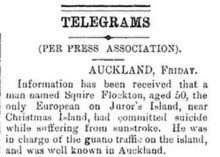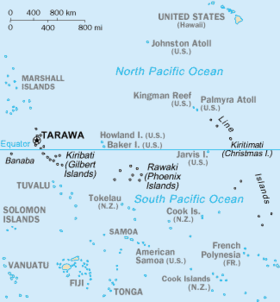Jarvis Island
Nickname: Bunker Island | |
|---|---|
UTC-11:00) | |
| ) | |
| Designated | 1974 |
Jarvis Island (/ˈdʒɑːrvɪs/; formerly known as Bunker Island or Bunker's Shoal) is an uninhabited 4.5 km2 (1.7 sq mi) coral island located in the South Pacific Ocean, about halfway between Hawaii and the Cook Islands.[1] It is an unincorporated, unorganized territory of the United States, administered by the United States Fish and Wildlife Service of the United States Department of the Interior as part of the National Wildlife Refuge system.[2] Unlike most coral atolls, the lagoon on Jarvis is wholly dry.
Jarvis is one of the Line Islands and for statistical purposes is also grouped as one of the United States Minor Outlying Islands. Jarvis Island is the largest of three U.S. equatorial possessions, which include Baker Island and Howland Island.[3]
It was claimed by the US in the 19th century and mined for guano, in the 20th century it was the subject of a small settlement. It was attacked during WW2 and evacuated, leaving some buildings and a day beacon. In modern times it is managed as a nature reserve.
Geography and ecology

While a few offshore anchorage spots are marked on maps, Jarvis island has no ports or harbors, and swift currents are a hazard. There is a boat landing area in the middle of the western shoreline near a crumbling
Jarvis Island is one of two United States territories that are in the
Jarvis Island was submerged underwater during the latest interglacial period, roughly 125,000 years ago, when sea levels were 5–10 meters (16–33 ft) higher than today. As the sea level declined, the horseshoe-shaped lagoon was formed in the center of Jarvis Island.[8]
Topographic isolation
Jarvis Island's highest point has a topographic isolation of 380.57 kilometers (236.48 mi; 205.49 nmi), with Joe's Hill on Kiritimati being the nearest higher neighbor.[9][10]
Time zone
Jarvis Island is located in the Samoa Time Zone (UTC -11:00), the same time zone as American Samoa, Kingman Reef, Midway Atoll, and Palmyra Atoll.
Birds
Jarvis Island once held some of the largest
History
Prehistory
Jarvis Island is unlikely to have hosted permanent human occupation prior to its use for guano mining. However, it is possible the island was utilized as a waypoint or stopover island by Polynesian voyagers. The remoteness of the island and a lack of freshwater resources have prevented large scale archaeological survey from taking place.[13]

Discovery
The island's first known sighting by the British on August 21, 1821, by the British ship Eliza Francis (or Eliza Frances) owned by Edward, Thomas and William Jarvis[14][15] and commanded by Captain Brown. The island was visited by whaling vessels until the 1870s.
The
Nineteenth-century guano mining
The American Guano Company, which was incorporated in 1857, established claims in respect of Baker Island and Jarvis Island which was recognized under the U.S.
For the following 21 years, Jarvis was commercially mined for guano, sent to the United States as fertilizer, but the island was abruptly abandoned in 1879, leaving behind about a dozen buildings and 8,000 metric tons (8,800 short tons) of mined guano.

New Zealand
John T. Arundel & Co. resumed mining guano from 1886 to 1899.[24][25] The United Kingdom annexed the island on June 3, 1889. Phosphate and copra entrepreneur John T. Arundel visited the island in 1909 on maiden voyage of the S.S. Ocean Queen and near the beach landing on the western shore members of the crew built a pyramidal day beacon made from slats of wood, which was painted white.[23] The beacon was standing in 1935,[26] and remained until at least 1942.
Wreck of barquentine Amaranth

On August 30, 1913, the
Millersville (1935–1942)

Jarvis Island was reclaimed by the United States government and colonized from March 26, 1935, onwards, under the
At the beginning of

International Geophysical Year
Jarvis was visited by scientists during the International Geophysical Year from July 1957 until November 1958. In January 1958 all scattered building ruins from both the nineteenth century guano diggings and the 1935–1942 colonization attempt were swept away without a trace by a severe storm which lasted several days and was witnessed by the scientists. When the IGY research project ended the island was abandoned again.[31] By the early 1960s a few sheds, a century of accumulated trash, the scientists' house from the late 1950s and a solid, short lighthouse-like day beacon built two decades before were the only signs of human habitation on Jarvis.
National Wildlife Refuge

On June 27, 1974, Secretary of the Interior
A feral cat population, descendants of cats likely brought by colonists in the 1930s, wrought disruption to the island's wildlife and vegetation. These cats were removed through efforts which began in the mid-1960s and lasted until 1990 when they were completely eradicated.[34] Since cats were removed, seabird numbers and diversity have increased.[35]
Nineteenth-century tram track remains can be seen in the dried lagoon bed at the island's center and the late 1930s-era lighthouse-shaped day beacon still stands on the western shore at the site of Millersville.
Public entry to anyone, including U.S. citizens, on Jarvis Island requires a special-use permit and is generally restricted to scientists and educators. The U.S. Fish and Wildlife Service and the United States Coast Guard periodically visit Jarvis.[6]
Transportation
 Jarvis Island Light in 2003 | |
 | |
| Location | Jarvis Island, Line Islands, US |
|---|---|
| Coordinates | 0°22′14″S 160°00′24″W / 0.37044°S 160.00669°W |
| Tower | |
| Constructed | 1935 |
| Construction | masonry |
| Height | 5 m (16 ft) |
| Shape | circular truncated tower, no lantern[36] |
| Markings | stripe (red, white, horizontal direction) |
| Light | |
| Deactivated | 1942 |
There is no airport on the island, nor does the island contain any large terminal or port. There is a day beacon near the middle of the west coast which is poor condition and no longer painted. Some offshore anchorage is available.[37]
Military
As a U.S. territory, the defense of Jarvis Island is the responsibility of the United States. All laws of the United States are applicable on the island.[37]
See also
- Howland and Baker islands
- List of Guano Island claims
- Under a Jarvis Moon, an 88-minute 2010 documentary
References
- ISBN 978-0-520-03282-8.
- ^ a b c "Jarvis Island". DOI Office of Insular Affairs. Archived from the original on February 7, 2012. Retrieved January 26, 2007.
- ISBN 9780824846794.
- CIA. 2003. Archived from the originalon September 8, 2006. Retrieved January 26, 2007.
- ^ Pacific Remote Islands National Wildlife Refuge Complex, Jarvis Island NWR Draft CCP EA, August 2007, retrieved November 25, 2010: "No information is available on the subsurface hydrology of Jarvis Island. However, its small size and prevailing arid rainfall conditions would not likely result in the formation of a drinkable groundwater lens. During staff visits to Jarvis, potable water is carried in containers to the island for short visits."
- ^ a b "United States Pacific Island Wildlife Refuges". Retrieved January 26, 2007.
- ^ "Jarvis Island – Pacific Biodiversity Information Forum photographs". Archived from the original on February 11, 2008. Retrieved January 9, 2008.
- ISBN 9780824846794.
- ^ "Jarvis High Point, U.S. Minor Pacific Islands". Retrieved October 18, 2020.
- ^ "Joes Hill, Kiribati". Retrieved October 18, 2020.
- ISBN 9780824846794.
- ^ "Jarvis Island". BirdLife Data Zone. BirdLife International. 2021. Retrieved January 23, 2021.
- ^ Jarvis Island National Wildlife Refuge: Comprehensive Conservation Plan (Report). U.S. Fish & Wildlife Service. September 24, 2008. Retrieved June 1, 2022.
- ^ "North Pacific Pilot page 282". Archived from the original (png) on February 11, 2008. Retrieved January 26, 2007.
- ^ "R. v. Higgins, Fuller, Anderson, Thomas, Belford and Walsh". legal proceeding. Archived from the original on October 15, 2015. Retrieved January 25, 2007.
- ISBN 978-0520025578.
- ^ "GAO/OGC-98-5 – U.S. Insular Areas: Application of the U.S. Constitution". U.S. Government Printing Office. November 7, 1997. Retrieved March 23, 2013.
- ^ "The Guano Companies in Litigation—A Case of Interest to Stockholders". New York Times. May 3, 1865. Retrieved March 23, 2013.
- Honolulu Star Bulletin.
- .
- ^ Auckland Star, Volume XIX, Issue 3978, 28 April 1883. p. 2.
- ISBN 978-1-107-00413-9.
- ^ a b Arundel, Sydney (1909). "Kodak photographs, Jarvis Island". Steve Higley. Retrieved April 23, 2013.
- OCLC 3444055.
- ISBN 978-0-522-84302-6.
- ^ Edwin H. Bryan, Jr. (1974). "Panala'au Memoirs". Pacific Scientific Information Center – Bernice P. Bishop Museum, Honolulu, Hawaii. Retrieved April 23, 2013.
- ^ Bryan, E.H. "Jarvis Island" Archived May 25, 2017, at the Wayback Machine Retrieved: July 7, 2008.
- ^ Bryan, Edwin H., Jr. Panala'au Memoirs. Retrieved: July 7, 2008. Contains several photos of the Millersville settlement, together with a diary of events in the colony.
- ^ "Sixteenth Census of the United States: Population, Volume I, Number of Inhabitants, Hawaii (Table 4)", United States census, 1940; Washington, D.C.; page 1211,. Retrieved on October 29, 2021.
- ^ "History of Jarvis Island". "World War Two" section of article. Retrieved January 25, 2007. Shell holes were later noted in the aircraft landing area.
- ^ The IGY station chief was Otto H Homung (d. 1958) who apparently died on the island and may have been buried there.
- ^ White, Susan (October 26, 2011). "Welcome to Jarvis Island National Wildlife Refuge". U.S. Fish and Wildlife Service. Archived from the original on September 4, 2014. Retrieved March 4, 2012.
- ^ Bush, George W. (January 6, 2009). "Establishment of the Pacific Remote Islands Marine National Monument: A Proclamation by the President of the United States of America". White House. Retrieved March 4, 2012.
- ^ "Jarvis Island National Wildlife Refuge". U.S. Fish and Wildlife Service. Retrieved March 4, 2012.
- ^ Rauzon, M. J.; Forsell, D. J.; Flint, E. N.; Gove, J. M. (2011). "Howland, Baker and Jarvis Islands 25 years after cat eradication: the recovery of seabirds in a biogeographical context". Island Invasives: Eradication and Management (PDF). p. 346.
- ^ Rowlett, Russ. "Lighthouses of U.S. Pacific Remote Islands". The Lighthouse Directory. University of North Carolina at Chapel Hill. Retrieved November 7, 2016.
- ^ a b "The World Factbook — Central Intelligence Agency". www.cia.gov. Retrieved September 6, 2018.
External links
- Jarvis Island Home Page Website with photos, weather, and more.
- Jarvis Island information website Has several photos of the old Millersville settlement, together with more modern photos of the island.
- WorldStatesmen Offers brief data on Jarvis island.
- U.S. Fish & Wildlife Service Jarvis Island National Wildlife Refuge The Jarvis Island refuge site.


